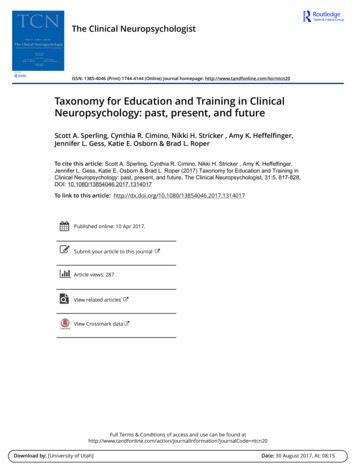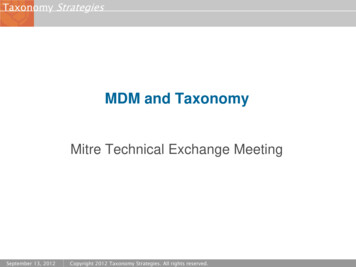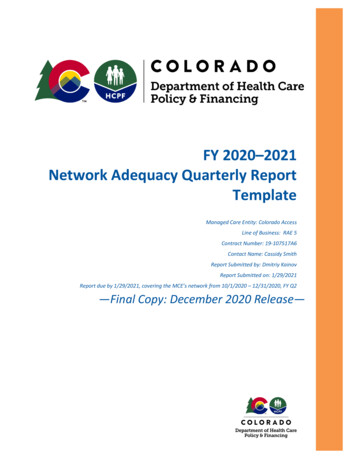
Transcription
The Clinical NeuropsychologistISSN: 1385-4046 (Print) 1744-4144 (Online) Journal homepage: http://www.tandfonline.com/loi/ntcn20Taxonomy for Education and Training in ClinicalNeuropsychology: past, present, and futureScott A. Sperling, Cynthia R. Cimino, Nikki H. Stricker , Amy K. Heffelfinger,Jennifer L. Gess, Katie E. Osborn & Brad L. RoperTo cite this article: Scott A. Sperling, Cynthia R. Cimino, Nikki H. Stricker , Amy K. Heffelfinger,Jennifer L. Gess, Katie E. Osborn & Brad L. Roper (2017) Taxonomy for Education and Training inClinical Neuropsychology: past, present, and future, The Clinical Neuropsychologist, 31:5, 817-828,DOI: 10.1080/13854046.2017.1314017To link to this article: lished online: 10 Apr 2017.Submit your article to this journalArticle views: 287View related articlesView Crossmark dataFull Terms & Conditions of access and use can be found tion?journalCode ntcn20Download by: [University of Utah]Date: 30 August 2017, At: 08:15
The Clinical Neuropsychologist, 2017VOL. 31, NO. 5, 4017Taxonomy for Education and Training in ClinicalNeuropsychology: past, present, and futureScott A. Sperlinga, Cynthia R. Ciminob, Nikki H. StrickercJennifer L. Gesse, Katie E. Osbornf and Brad L. Roperg, Amy K. Heffelfingerd,Downloaded by [University of Utah] at 08:15 30 August 2017aDepartment of Neurology, University of Virginia, Charlottesville, VA, USA; bDepartment of Psychology,University of South Florida, Tampa, FL, USA; cDepartment of Psychiatry and Psychology, Mayo Clinic, Rochester,MN, USA; dDepartment of Neurology, Medical College of Wisconsin, Milwaukee, WI, USA; eUniversity of Arkansasfor Medical Sciences, Little Rock, AR, USA; fVanderbilt Memory & Alzheimer’s Center, Vanderbilt UniversityMedical Center, Nashville, TN, USA; gDepartment of Veterans Affairs Medical Center, Memphis, TN, USAABSTRACTObjective: Historically, the clinical neuropsychology trainingcommunity has not clearly or consistently defined education ortraining opportunities. The lack of consistency has limited students’and trainees’ ability to accurately assess and compare the intensity ofneuropsychology-specific training provided by programs. To addressthese issues and produce greater ‘truth in advertising’ across programs,CNS, with SCN’s Education Advisory Committee (EAC), ADECN, AITCN,and APPCN constructed a specialty-specific taxonomy, namely, theTaxonomy for Education and Training in Clinical Neuropsychology. Thetaxonomy provides consensus in the description of training offered bydoctoral, internship, and postdoctoral programs, as well as at the postlicensure stage. Although the CNS approved the taxonomy in February2015, many programs have not adopted its language. Increasedawareness of the taxonomy and the reasons behind its developmentand structure, as well as its potential benefits, are warranted. Methods:In 2016, a working group of clinical neuropsychologists from the EACand APPCN, all authors of this manuscript, was created and tasked withdisseminating information about the taxonomy. Group members heldregular conference calls, leading to the generation of this manuscript.Results: This manuscript is the primary byproduct of the workinggroup. Its purpose is to (1) outline the history behind the developmentof the taxonomy, (2) detail its structure and utility, (3) address theexpected impact of its adoption, and (4) call for its adoption acrosstraining programs. Conclusions: This manuscript outlines thedevelopment and structure of the clinical neuropsychology taxonomyand addresses the need for its adoption across training programs.ARTICLE HISTORYReceived 19 December 2016Accepted 24 March 2017KEYWORDSNeuropsychology; taxonomy;training; education;guidelinesBackgroundHistorically, a lack of consistency in definitions to describe education and training opportunities has existed across the professional psychology training community (AmericanPsychological Association [APA], 2009a, Section 90-5). Professional organizations and groupsCONTACT Scott A. Sperlingsas7yr@virginia.edu 2017 Informa UK Limited, trading as Taylor & Francis Group
Downloaded by [University of Utah] at 08:15 30 August 2017818 S. A. SPERLING ET AL.have used different terminology in their description of doctoral, internship, and postdoctoralprograms. For example, the Association of Psychology Postdoctoral and Internship Centers(APPIC) has used the terms ‘major rotation’ and ‘informal/minor/external rotation’ in describing internship training programs (https://membership.appic.org/directory/search; APPIC,2016), whereas the APA accreditation regulations have allowed accredited programs to offerone or more ‘areas of emphasis’ (APA Commission on Accreditation, 2014). However, becausethese terms were never defined or regulated (APA Commission on Accreditation, 2014), therehas been a significant lack of consistency in how they have been applied across trainingprograms. To this point, a qualitative review of 35 randomly selected websites of APAaccredited graduate programs in clinical, counseling, and school psychology discoveredinconsistent usage of terms used to describe training in recognized specialties (APA, 2011)and learning opportunities (Nutt, 2006). This lack of consistency has not only hindered students’ and trainees’ ability to accurately evaluate and compare prospective academic andtraining programs, it has limited efficient communication and thus a clear understandingof the education and training of professional psychologists beyond the broad and generaltraining consistent with accreditation standards (APA, 2009b, 2015).When implemented discipline-wide, taxonomies have the power to overcome these issuesthrough the provision of a structured framework and common language for describingtraining opportunities. The potential benefits of a taxonomy for professional psychologyhave long been discussed by multiple groups and organizations, including the APA’sCommission for the Recognition of Specialties and Proficiencies in Professional Psychology(CRSPPP), the Council of Specialties in Professional Psychology (CoS), and the Council ofCredentialing Organizations in Professional Psychology (CCOPP). Unfortunately, despite bestintentions, most early efforts to define clear and consistent terms to describe the professionof psychology and the education and training opportunities therein, failed to produceinter-organizational agreement or led to APA policy (Rozensky et al., 2015). In 2005, the APATask Force on Quality Assurance of Education and Training for Recognized Proficiencies inProfessional Psychology openly recognized these issues, stating that ‘there appears to be aneed for a clearer taxonomy of terminology in describing the structure of professional psychology, from its education and training foundations, through credentialing and practicerepresentations to the public’ (APA, Task Force on Quality Assurance of Education and Trainingfor Recognized Proficiencies in Professional Psychology, 2005). Also directly recognizing theneed for a taxonomy, in 2006 the APA’s CRSPPP, CoS, and CCOPP held a series of discussionsaimed at organizing and clearly defining the terminology used to describe education andtraining opportunities within professional psychology (APA, Task Force on the Assessmentof Competence in Professional Psychology, 2006). One year later, an APA task force wasformed and tasked with formally developing a taxonomy. The CRSPPP then built upon thistask force’s final work product. Via ongoing collaboration with multiple constituency groups,including the CoS, American Board of Professional Psychology (ABPP), and CCOPP, and afterfeedback on early iterations of the taxonomy was solicited and incorporated from professionals and the public (Rozensky, 2010a, 2010b), a final version of the taxonomy was created,adopted as APA policy, and published as Education and Training Guidelines: A Taxonomy forEducation and Training in Professional Psychology Health Service Specialties (APA, 2012). Forthe first time, these guidelines established a structure and consistent set of terms and definitions related to education and training to be utilized across each of the health servicepsychology specialties (APA, 2011) recognized by the APA. Specifically, CRSPPP requested
THE CLINICAL NEUROPSYCHOLOGIST 819that all specialties develop their own taxonomy using the terms ‘Major Area of Study,’‘Emphasis,’ ‘Experience,’ and ‘Exposure’ to define the intensity of training opportunities ateach stage of the training sequence or decide whether these terms were applicable at agiven training stage. Thus, CRSPPP authored the framework for the general APA taxonomy,individual specialties, including clinical neuropsychology, were tasked with defining theintensity levels for their respective specialties.Downloaded by [University of Utah] at 08:15 30 August 2017Development of the Taxonomy for Education and Training in ClinicalNeuropsychologyIn discussing the development of the Taxonomy for Education and Training in ClinicalNeuropsychology (see Table 1), it is first necessary to place it in the context of other documentsand efforts relevant to education and training. The taxonomy was, in fact, built upon anexisting foundation of education and training guidelines, including the requirements foraccreditation by the APA and the Canadian Psychological Association (CPA) and the PolicyStatement from the Houston Conference on Specialty Education and Training in ClinicalNeuropsychology (Hannay et al., 1998), or so-called ‘Houston Conference Guidelines’ (HCG).The latter specifically outlines clinical neuropsychology’s overarching training guidelines,including delineation that specialization take place at all stages of training (i.e. doctoral, internship, and postdoctoral) and that completion of a two-year postdoctoral program is requiredfor specialization. The clinical neuropsychology taxonomy was developed to be consistentwith and supportive of the HCG, not to supplant them, by offering specific and commondefinitions for programs to apply to their HCG-consistent training. At the doctoral and internship training levels, it is recognized that all programs must meet the broad and generalrequirements for accreditation established by the APA or CPA. At the postdoctoral traininglevel, the expectations for designation as a Major Area of Study are consistent with the trainingstandards for specialty accreditation in clinical neuropsychology through the APA.In the case of clinical neuropsychology, the request for the development of a specialtyspecific taxonomy was conveyed to the Clinical Neuropsychology Synarchy (CNS), whichserves as representative to the CoS. Participating members of CNS include the major professional and training organizations in neuropsychology in the United States: AmericanAcademy of Clinical Neuropsychology (AACN), the American Board of Clinical Neuropsychology(ABCN), American Board of Professional Neuropsychology (ABN), the Association for DoctoralEducation in Clinical Neuropsychology (ADECN), the Association for Internship Training inClinical Neuropsychology (AITCN), the Association of Postdoctoral Programs in ClinicalNeuropsychology (APPCN), Society for Clinical Neuropsychology (SCN; APA Division 40), andthe National Academy of Neuropsychology (NAN).The CNS developed an initial taxonomy for clinical neuropsychology in Spring 2014 andsubsequently sent this to the CoS who then forwarded it to CRSPPP. CRSPPP asked for additional clarity of terms at various levels of intensity and training. CNS then forwarded theinitial taxonomy to the Education Advisory Committee (EAC) of the SCN, which comprisedmembers that represent doctoral, internship, and postdoctoral training levels. Over a periodof approximately six months, the EAC sought further input from members of the majortraining organizations in neuropsychology, including ADECN, AITCN, and APPCN. Each organization provided feedback with respect to the level of intensity within each stage of theeducation and training sequence. This resulted in vigorous discussion, deliberation, and
30% and 50% of experience in clinicalneuropsychology supervised by a clinical neuropsychologist 10% and 30% of supervisedN/Aexperience in clinical neuropsychology5–10% of supervised experience inN/Aclinical neuropsychology and/ordidactic training(1) Two neuropsychology coursesb AND (2) twoclinical neuropsychology practicac(1) One or two neuropsychology course(s)c AND(2) one clinical neuropsychology practicumc(1) One neuropsychology courseb OR (2) oneclinical neuropsychology practicumcExperienceAny hours of CE in es: As per APA guidelines all supervision in clinical neuropsychology must be provided by persons with competencies in clinical neuropsychology, aka, a clinical neuropsychologist.aAt the doctoral and internship training levels, it is recognized that all programs must meet the broad and general requirements for accreditation by the American Psychological Association (APA)or the CPA. At the postdoctoral training level, it is recognized that the Major Area of Study is consistent with training standards for specialty accreditation in clinical neuropsychology through theAPA. Regarding all levels of training, guidelines for specialty education and training in clinical neuropsychology are specified in the Houston Conference Guidelines, Hannay, JH, Bieliauskas, LA,Crosson, BA, Hammeke, TA, Hammsher, K. deS., & Koffler, SP. (1998). Proceedings of the Houston Conference on Specialty Education and Training in Clinical Neuropsychology, Archives of ClinicalNeuropsychology, 13, 157–250.bTo be a neuropsychology course, the course content must prominently address areas outlined in the Houston Conference Guidelines policy statement, Section VI.3 and Section VI.4. Additionally,the number of courses listed above assumes that courses are three credit hours each, within a semester system. As such, the Major Area of Study would require a minimum of nine semester credithours or 13.5 quarter credit hours, the Emphasis would require a minimum of six semester credit hours or nine quarter credit hours, and the Experience and the Exposure would require a minimumof three semester credit hours or 4.5 quarter credit hours.ExposureMajor Area of StudyEmphasisPostdoctorala(1) Two-years full time (or the equivalentg) offormal training in clinical neuropsychology, with relevant didactic, clinical, andresearch activities (including assessmentand intervention that incorporateneuropsychological theories, perspectives,or methods and exposure to relatedhealthcare disciplines)N/AInternshipa(1) At least 50% of training time inclinical neuropsychology AND (2)didactic experiences consistent withHouston Conference guidelines forknowledgee and skillfDoctoralaMinimum of (1) three neuropsychologyb courses,(2) two clinical neuropsychology practicac, (3)additional coursework, practica, or didactics inclinical neuropsychologyd, AND (4) dissertationor research project in neuropsychologyTable 1. Taxonomy for Education and Training in Clinical Neuropsychology.Downloaded by [University of Utah] at 08:15 30 August 2017820 S. A. SPERLING ET AL.
Defined by practicum experience for equivalent of one academic year (e.g. 9 months, in semester or quarter systems) consisting of supervised training for at least 8 h per week, with at least 50%clinical contact with patients in the provision of neuropsychological services.dAdditional training experiences can also include, but are not limited to, research experiences, lab meetings, brown bags, lecture/colloquia series, grand rounds, etc. and should be consistent withthe guidelines for specialty education and training that are specified in the Houston Conference policy statement.eKnowledge base. Clinical neuropsychologists possess the following knowledge. This core knowledge may be acquired through multiple pathways, not limited to courses, and may come throughother documentable didactic methods.1. Generic Psychology Core: A. Statistics and methodology B. Learning, cognition and perception C. Social psychology and personality D. Biological basisof behavior E. Life span development F. History. G. Cultural and individual differences and diversity 2. Generic Clinical Core: A. Psychopathology B. Psychometric theory C. Interview and assessment techniques D. Intervention techniques E. Professional ethics 3. Foundations for the study of brain-behavior relationships: A. Functional neuroanatomy B. Neurological and related disorders including their etiology, pathology, course and treatment C. Non-neurologic conditions affecting CNS functioning D. Neuroimaging and other neurodiagnostic techniques E. Neurochemistryof behavior (e.g. psychopharmacology) F. Neuropsychology of behavior 4. Foundations for the practice of clinical neuropsychology: A. Specialized neuropsychological assessment techniquesB. Specialized Neuropsychological intervention techniques C. Research design and analysis in neuropsychology D. Professional issues and ethics in neuropsychology E. Practical implications ofneuropsychological conditions.fSkills. Clinical neuropsychologists possess the following generic clinical skills and skills in clinical neuropsychology. These core skills may be acquired through multiple pathways, not limited tocourses, and may come through other documentable didactic methods. Domains of skills and examples are: 1. Assessment: Information gathering. History taking. Selection of tests and measures.Administration of tests and measures. Interpretation and diagnosis. Treatment planning. Report writing. Provision of feedback. Recognition of multicultural issues. 2. Treatment and Interventions:Identification of intervention targets. Specification of intervention needs. Formulation of an intervention plan. Implementation of the plan. Monitoring and adjustment to the plan as needed.Assessment of outcome. Recognition of multicultural issues. 3. Consultation (patients, families, medical colleagues, agencies, etc.): A. Effective basic communication (e.g. listening, explaining, andnegotiating) B. Determination and clarification of referral issues C. Education of referral sources regarding neuropsychological services (strengths and limitations) E. Communication of evaluationresults and recommendations F. Education of patients and families regarding services and disorder(s) 4. Research: Selection of appropriate research topics. Review of relevant literature. Design ofresearch. Execution of research. Monitoring of progress. Evaluation of outcome. Communication of results. 5. Teaching and Supervision: Methods of effective teaching. Plan and design of coursesand curriculums. Use of effective educational technologies. Use of effective supervision methodologies (assessment, intervention, and research).gThe residency experience must occur on at least a half-time basis.cDownloaded by [University of Utah] at 08:15 30 August 2017THE CLINICAL NEUROPSYCHOLOGIST 821
822 S. A. SPERLING ET AL.debate until a consensus was established at each stage of training. A final document wassent back to the CNS and was adopted in February 2015.Downloaded by [University of Utah] at 08:15 30 August 2017Structure of the taxonomyThe taxonomy establishes hierarchical definitions of education and training opportunitieswithin academic, clinical, and research domains at each of the four stages in the sequenceof professional training: doctoral, internship, postdoctoral, and post-licensure. The parameters for the content and range of experiences necessary to meet each level of intensity aredefined by the taxonomy. Importantly, as described in the ‘Doctoral Program’ section below,the taxonomy also establishes guidelines regarding the content that needs to be coveredto constitute a neuropsychology course and provides much needed clarity as to what constitutes a ‘practicum’ in clinical neuropsychology. In this way, all programs now have a universal means of consistently describing the specific types and number of trainingopportunities they offer. Ultimately, the totality of each program’s education and trainingofferings will meet the definition for only one of four levels of training intensity. In orderfrom highest to lowest intensity, these levels are Major Area of Study, Emphasis, Experience,and Exposure. The specific definitions for each level at each stage of training are outlined intheir respective sections below. In general, and in keeping consistent with the broad definitions established in the APA general taxonomy (APA, 2012), each level provides the following degree of training intensity within clinical neuropsychology: Major Area of Study: conveys the highest level of education and training opportunityavailable in clinical neuropsychology at each stage, with respect to both the intensityand amount of involvement in training. Emphasis: provides in-depth coursework and/or supervised training in clinical neuropsychology, but not at the level defined by Major Area of Study. Experience: affords individuals with a greater opportunity to obtain knowledge andskills than would be possible solely via an Exposure, but is still limited in scope. Exposure: represents an education or training opportunity that is limited in type andintensity. This may consist of a structured learning activity, such as a didactic, singlecourse, or circumscribed clinical experience designed as an opportunity to acquaintan individual with neuropsychology.Doctoral programsWithin doctoral programs, a designation of neuropsychology as a Major Area of Studyrequires a minimum of (1) three neuropsychology courses with content that prominentlyaddresses foundations for the study of brain–behavior relationships and foundations for thepractice of clinical neuropsychology as outlined in the HCG, (2) two clinical neuropsychologypractica, with a practicum defined as lasting the equivalent of one academic year and consisting of supervised training for at least 8 h per week, with at least 50% of time devoted toclinical contact with patients in the provision of neuropsychological services, (3) additionalcoursework, practica, or didactics in clinical neuropsychology, and (4) completion of a dissertation or research project in neuropsychology. The level of Emphasis requires two neuropsychology courses and two neuropsychology practica. In contrast, the level of Experience
Downloaded by [University of Utah] at 08:15 30 August 2017THE CLINICAL NEUROPSYCHOLOGIST 823requires one or two neuropsychology courses and one neuropsychology practicum, whilethe level of Exposure requires only one of either.A practical example is provided in Table 2. As an additional exemplar, the future websiteof an APA-accredited doctoral program offering a Major Area of Study in ClinicalNeuropsychology might read:The internship program at X University is accredited by the APA and offers a Major Areaof Study in Clinical Neuropsychology. Students in this training program will be required toenroll in at least three neuropsychology courses covering the foundations of brain behaviorrelationships and practice of clinical neuropsychology, and will complete a dissertation inthe area of neuropsychology. Within the Department of Psychology, there is additional didactic training in specific areas of clinical neuropsychology in which the neuropsychology students will take part. Clinical training will include at least two clinical neuropsychologypractica, with at least 50% of each being dedicated to the provision of clinical neuropsychology services to various patient populations.Internship programsFor internship programs, a Major Area of Study in neuropsychology requires (1) at least 50%of training time be devoted to clinical neuropsychology, and (2) didactic experiences consistent with the HCG for knowledge and skill. The involvement in supervised clinical neuropsychology experience reduces to 30–50% at the level of Emphasis and 10–30% at thelevel of Experience. A programatic Exposure requires only 5–10% of supervised experiencein clinical neuropsychology and/or didactic training.A practical example is provided in Table 3. As an additional exemplar, the future websiteof an APA-accredited internship program offering an Experience or Exposure in ClinicalNeuropsychology may read as follows:Our APA-accredited internship program offers an Experience in Clinical Neuropsychology,with 25% of the intern’s time dedicated to training in clinical neuropsychology. In additionto clinical training, the program offers didactic experiences focused in the area ofTable 2. Taxonomy for Education and Training in Clinical Neuropsychology: doctoral example. Professor Jane, University X: ‘My doctoral program offers a “concentration” in neuropsychology. Is it an “Emphasis” or a“Major Area of Study” in clinical neuropsychology?’The program provides/requires: Neuropsychology dissertation Two courses devoted to clinical neuropsychology One nine-month neuropsychology practicum University X’s training program meets criteria for an ‘Experience’ in clinical neuropsychology. It does not meet the‘two practicum’ requirement for a Major Area of Study or an EmphasisTable 3. Taxonomy for Education and Training in Clinical Neuropsychology: internship example. Training Director Jim, Hospital Z: ‘My internship program offers a “major rotation” in neuropsychology. Is it a MajorArea of Study?’The program provides/requires: 30% time in the provision of supervised clinical neuropsychology service Weekly didactic in brain-behavior relationships Hospital Z’s training program meets criteria for an ‘Emphasis’ in clinical neuropsychology. It does not meet the ‘50%of training time in clinical neuropsychology’ requirement for a Major Area of Study
824 S. A. SPERLING ET AL.neuropsychology. Alternatively, should an intern elect, our program offers an Exposure inClinical Neuropsychology, which includes the option of participating in the aforementioneddidactics and/or supervised clinical training in neuropsychology for 10% of the training year.Downloaded by [University of Utah] at 08:15 30 August 2017Postdoctoral programsConsistent with the HCG, specialization in clinical neuropsychology occurs only throughpostdoctoral programs offering a Major Area of Study. This level of education and trainingexperience mandates two-years of full-time (or the equivalent) of formal training in clinicalneuropsychology, with the inclusion of relevant didactic, clinical, and research activities.These activities include clinical assessment and intervention that incorporate neuropsychological theories, perspectives, or methods and exposure to related healthcare disciplines.The APA general taxonomy framework indicates that only Major Area of Study and Exposurecan be defined at the postdoctoral level, and the Major Area of Study for all specialties mustrequire 80% or more time spent in specialty training (APA, 2012, p. 7). In contrast, the clinicalneuropsychology taxonomy requires that all training be within the specialty.As a practical example, the future website of a postdoctoral program offering a MajorArea of Study in Clinical Neuropsychology may read as follows:The Postdoctoral Fellowship at Y Medical Center offers a Major Area of Study in ClinicalNeuropsychology and meets all of the requirements outlined in the HCG. This two-year program offers full-time formal training in the area of clinical neuropsychology. Clinical experiences include clinical assessment and intervention and require collaboration with colleaguesin the Departments of Neurology, Neurosurgery, and Physical Medicine and Rehabilitationas needed on a case-by-case basis. In addition to clinical training, fellows will attend a caseconference and didactic series dedicated to Neuropsychology, in addition to optional didacticsoffered through the departments of Psychiatry, Neuropathology, Neurology, and Neurosurgery.Opportunities also exist for fellows to participate in clinical research.Post-licensureMost state or provincial licensing boards require clinical neuropsychologists to engage inannual continuing education (CE). The goal of CE is to maintain or improve establishedcompetencies, either by updating previously acquired knowledge and/or skills or by developing new knowledge and/or skills. However, CE is not a method for acquiring core knowledge or skills to practice as a clinical neuropsychologist. As such, at the post-licensure stage,there is no mechanism for gaining education or training in clinical neuropsychology beyondthe level of Exposure. Any hours of CE in clinical neuropsychology are considered at the levelof Exposure.Expected impactThe collective use of the taxonomy’s terminology and programmatic descriptors will helpclinical neuropsychology training programs more accurately and consistently describe thecontent and range of training opportunities. This taxonomy will also help programs wishingto offer a certain level of training intensity know how to modify their program to meet theminimum specifications required for their desired level of intensity. Perhaps most
Downloaded by [University of Utah] at 08:15 30 August 2017THE CLINICAL NEUROPSYCHOLOGIST 825importantly, consistency in the language used when describing and promoting their education and training structure to prospective students/trainees will contribute to greater‘truth in advertising’ across programs. This in turn may lead to less uncertainty and uneaseamongst prospective students/trainees about the actual available opportunities, experiences, and requirements inherent in each program, while simultaneously helping them toaccurately compare the intensity of training opportunities available across different programs. Adoption of the taxonomy may also alleviate fear and uncertainty on the behalf ofstudents/trainees as to whether or
The clinical neuropsychology taxonomy was developed to be consistent with and supportive of the HCG, not to supplant them, by offering specific and common definitions for programs to apply to their HCG-consistent training. At the doctoral and intern - ship training levels, it is recognized that all programs must meet the broad and general











